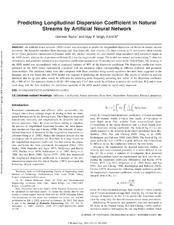Predicting Longitudinal Dispersion Coefficient in Natural Streams by Artificial Neural Network
Date
2005-11-01Metadata
Show full item recordAbstract
An artificial neural network (ANN) model was developed to predict the longitudinal dispersion coefficient in natural streams and rivers. The hydraulic variables [flow discharge (Q), flow depth (H), flow velocity (U), shear velocity (u*), and relative shear velocity (U/u*)] and geometric characteristics [channel width (B), channel sinuosity (σ), and channel shape parameter (β)] constituted inputs to the ANN model, whereas the dispersion coefficient (Kx) was the target model output. The model was trained and tested using 71 data sets of hydraulic and geometric parameters and dispersion coefficients measured on 29 streams and rivers in the United States. The training of the ANN model was accomplished with an explained variance of 90% of the dispersion coefficient. The dispersion coefficient values predicted by the ANN model satisfactorily compared with the measured values corresponding to different hydraulic and geometric characteristics. The predicted values were also compared with those predicted using several equations that have been suggested in the literature and it was found that the ANN model was superior in predicting the dispersion coefficient. The results of sensitivity analysis indicated that the Q data alone would be sufficient for predicting more frequently occurring low values of the dispersion coefficient (Kx < 100 m²/s). For narrower channels (B/H<50) using only U/u* data would be sufficient to predict the coefficient. If β and σ were used along with the flow variables, the prediction capability of the ANN model would be significantly improved.
Department
Biological and Agricultural Engineering (College of Agriculture and Life Sciences)Collections
Citation
Singh, Vijay P.; Tayfur, Gokmen (2005). Predicting Longitudinal Dispersion Coefficient in Natural Streams by Artificial Neural Network. Available electronically from https : / /hdl .handle .net /1969 .1 /164674.


